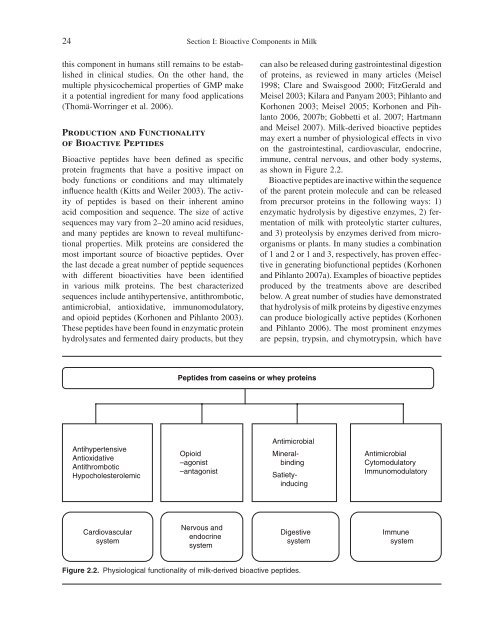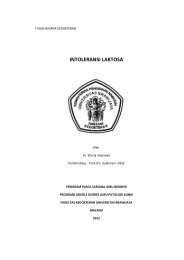- Page 1 and 2: Bioactive Components Milk in Dairy
- Page 4 and 5: Bioactive Components in Milk and Da
- Page 6 and 7: Contributors vii Foreword xi Table
- Page 8 and 9: Ryozo Akuzawa Department of Food Sc
- Page 10: Peter Williams Smart Foods Centre U
- Page 14: Bioactive Components in Milk and Da
- Page 17 and 18: 4 Overview of Bioactive Components
- Page 19 and 20: 6 Table 1.2. Examples of physiologi
- Page 21 and 22: 8 Overview of Bioactive Components
- Page 23 and 24: 10 Overview of Bioactive Components
- Page 25 and 26: 12 Overview of Bioactive Components
- Page 28 and 29: INTRODUCTION 2 Bioactive Components
- Page 30 and 31: contribute signifi cantly to daily
- Page 32 and 33: identifi ed a large number of minor
- Page 34 and 35: peptide β - lactosin B [Ala - Leu
- Page 38 and 39: Chapter 2: Bioactive Components in
- Page 40 and 41: BIOACTIVE LIPIDS Bovine milk fat is
- Page 42 and 43: 2006 ). The wide range of CLA value
- Page 44 and 45: and epithelial cells. Both forms of
- Page 46 and 47: REFERENCES Abd El - Salam , M.H. ,
- Page 48 and 49: Fong , B.Y. , Norris , C.S. , and P
- Page 50 and 51: Larsson , S.C. , Bergkvist , L. , a
- Page 52 and 53: viral properties of milk proteins a
- Page 54 and 55: Smithers , G.W. 2004 . Isolation of
- Page 56 and 57: 3 Bioactive Components in Goat Milk
- Page 58 and 59: goat milk cheese. In another study,
- Page 60 and 61: dB Buffering index ( ) dpH 0.09 0.0
- Page 62 and 63: Antihypertensive Antioxidative Anti
- Page 64 and 65: Chapter 3: Bioactive Components in
- Page 66 and 67: Cytomodulatory Peptides There is in
- Page 68 and 69: SBP, mmHg 220 200 180 160 140 ACE -
- Page 70 and 71: e greater than the sum of the indiv
- Page 72 and 73: in goat milk fat by feeding special
- Page 74 and 75: intake of dietary cholesterol, as w
- Page 76 and 77: ifi dus growth promoter, and it has
- Page 78 and 79: ferrin can retain iron at very low
- Page 80 and 81: solubility by the fermentation of u
- Page 82 and 83: Major Minerals Calcium Calcium is a
- Page 84 and 85: BIOACTIVE VITAMINS IN GOAT MILK Vit
- Page 86 and 87:
Edgar , W.M. 1993 . Extrinsic and i
- Page 88 and 89:
Pariza , and G.J. Nelson , eds. Ame
- Page 90 and 91:
Meisel , H. , and Schlimme , E. 199
- Page 92 and 93:
Regester , G.O. , Smithers , G.W. ,
- Page 94:
T.J. 1998 . Lactoferricin of bovine
- Page 97 and 98:
84 Section I: Bioactive Components
- Page 99 and 100:
86 Section I: Bioactive Components
- Page 101 and 102:
88 Section I: Bioactive Components
- Page 103 and 104:
90 Section I: Bioactive Components
- Page 105 and 106:
92 Table 4.5. Sequence of bioactive
- Page 107 and 108:
94 Section I: Bioactive Components
- Page 109 and 110:
96 Section I: Bioactive Components
- Page 111 and 112:
98 Section I: Bioactive Components
- Page 113 and 114:
100 Section I: Bioactive Components
- Page 115 and 116:
102 Section I: Bioactive Components
- Page 117 and 118:
104 Section I: Bioactive Components
- Page 119 and 120:
106 Section I: Bioactive Components
- Page 121 and 122:
108 Section I: Bioactive Components
- Page 123 and 124:
110 Section I: Bioactive Components
- Page 125 and 126:
112 Section I: Bioactive Components
- Page 127 and 128:
114 Table 5.6. N - terminal sequenc
- Page 129 and 130:
116 Section I: Bioactive Components
- Page 131 and 132:
118 Section I: Bioactive Components
- Page 133 and 134:
120 Section I: Bioactive Components
- Page 135 and 136:
122 Section I: Bioactive Components
- Page 137 and 138:
124 Section I: Bioactive Components
- Page 139 and 140:
126 Section I: Bioactive Components
- Page 141 and 142:
128 Section I: Bioactive Components
- Page 143 and 144:
130 Section I: Bioactive Components
- Page 145 and 146:
132 Section I: Bioactive Components
- Page 147 and 148:
134 Section I: Bioactive Components
- Page 149 and 150:
136 Section I: Bioactive Components
- Page 151 and 152:
138 Section I: Bioactive Components
- Page 153 and 154:
140 Section I: Bioactive Components
- Page 155 and 156:
142 Section I: Bioactive Components
- Page 157 and 158:
144 Section I: Bioactive Components
- Page 159 and 160:
146 Section I: Bioactive Components
- Page 161 and 162:
148 Section I: Bioactive Components
- Page 163 and 164:
150 Section I: Bioactive Components
- Page 165 and 166:
152 Section I: Bioactive Components
- Page 167 and 168:
154 Section I: Bioactive Components
- Page 169 and 170:
156 Section I: Bioactive Components
- Page 172 and 173:
INTRODUCTION 6 Bioactive Components
- Page 174 and 175:
milk, respectively. This ratio is i
- Page 176 and 177:
The amino acid compositions of came
- Page 178 and 179:
Recently, acid whey prepared from c
- Page 180 and 181:
Table 6.5. The average concentratio
- Page 182 and 183:
Chapter 6: Bioactive Components in
- Page 184 and 185:
ound amino acids in camel milk are
- Page 186 and 187:
Lactoferrin The inhibition effect o
- Page 188 and 189:
for 2 or 3 days; in this type, skin
- Page 190 and 191:
proteins are different in their com
- Page 192 and 193:
and lower content of short - chain
- Page 194 and 195:
Spitsberg 2005 ). Meanwhile, it has
- Page 196 and 197:
IGF - binding proteins (IGFBP 1 - 6
- Page 198 and 199:
Vitamin E is also low in camel milk
- Page 200 and 201:
Carlsson , A. , Bjorck , L. , and P
- Page 202 and 203:
FAO/WHO/UNU Expert Consultation . 1
- Page 204 and 205:
ovi , S. , Pekkanen , J. , Pekkarin
- Page 206 and 207:
experience and feeding patterns of
- Page 208 and 209:
7 Bioactive Components in Mare Milk
- Page 210 and 211:
Mare milk is quite similar to human
- Page 212 and 213:
Table 7.4. The vitamin contents of
- Page 214 and 215:
α - lactalbumin can interact with
- Page 216 and 217:
Carbohydrate Lactose is found in th
- Page 218 and 219:
cow milk, because IGF - Is in mare
- Page 220 and 221:
et al. (1986) once used natural mar
- Page 222 and 223:
De Oliveira , I.R. , de Araujo , A.
- Page 224 and 225:
Marconi , E. , and Panfi li , G. 19
- Page 226:
Summer , A. , Sabbioni , A. , Forma
- Page 230 and 231:
8 Bioactive Components in Caseins,
- Page 232 and 233:
Chapter 8: Bioactive Components in
- Page 234 and 235:
Chapter 8: Bioactive Components in
- Page 236 and 237:
223 Table 8.6. Immunomodulating and
- Page 238 and 239:
Chapter 8: Bioactive Components in
- Page 240 and 241:
Other Bioactive Components in Chees
- Page 242 and 243:
Chapter 8: Bioactive Components in
- Page 244 and 245:
Chapter 8: Bioactive Components in
- Page 246:
Chapter 8: Bioactive Components in
- Page 249 and 250:
236 Section II: Bioactive Component
- Page 251 and 252:
238 Section II: Bioactive Component
- Page 253 and 254:
240 Section II: Bioactive Component
- Page 255 and 256:
242 Section II: Bioactive Component
- Page 257 and 258:
244 Section II: Bioactive Component
- Page 259 and 260:
246 Section II: Bioactive Component
- Page 261 and 262:
248 Section II: Bioactive Component
- Page 263 and 264:
250 Section II: Bioactive Component
- Page 265 and 266:
252 Section II: Bioactive Component
- Page 267 and 268:
254 Section II: Bioactive Component
- Page 269 and 270:
256 Section II: Bioactive Component
- Page 271 and 272:
258 Section II: Bioactive Component
- Page 273 and 274:
260 Section II: Bioactive Component
- Page 275 and 276:
262 Section II: Bioactive Component
- Page 277 and 278:
264 Section II: Bioactive Component
- Page 279 and 280:
266 Section II: Bioactive Component
- Page 281 and 282:
268 Section II: Bioactive Component
- Page 283 and 284:
270 Section II: Bioactive Component
- Page 285 and 286:
272 Table 11.5. Continued Component
- Page 287 and 288:
274 Section II: Bioactive Component
- Page 289 and 290:
276 Section II: Bioactive Component
- Page 291 and 292:
278 Section II: Bioactive Component
- Page 293 and 294:
280 Section II: Bioactive Component
- Page 295 and 296:
282 Section II: Bioactive Component
- Page 297 and 298:
284 Section II: Bioactive Component
- Page 300 and 301:
12 Probiotics and Prebiotics as Bio
- Page 302 and 303:
Chapter 12: Probiotics and Prebioti
- Page 304 and 305:
Chapter 12: Probiotics and Prebioti
- Page 306 and 307:
Chapter 12: Probiotics and Prebioti
- Page 308 and 309:
Chapter 12: Probiotics and Prebioti
- Page 310 and 311:
Chapter 12: Probiotics and Prebioti
- Page 312 and 313:
Chapter 12: Probiotics and Prebioti
- Page 314 and 315:
therapeutic use. Stimulating agents
- Page 316 and 317:
Chapter 12: Probiotics and Prebioti
- Page 318 and 319:
Chapter 12: Probiotics and Prebioti
- Page 320 and 321:
Chapter 12: Probiotics and Prebioti
- Page 322 and 323:
Chapter 12: Probiotics and Prebioti
- Page 324:
Section III Other Related Issues on
- Page 327 and 328:
314 Section III: Other Related Issu
- Page 329 and 330:
316 Section III: Other Related Issu
- Page 331 and 332:
318 Section III: Other Related Issu
- Page 333 and 334:
320 Section III: Other Related Issu
- Page 335 and 336:
322 Section III: Other Related Issu
- Page 337 and 338:
324 Section III: Other Related Issu
- Page 339 and 340:
326 Section III: Other Related Issu
- Page 342 and 343:
14 New Technologies for Isolation a
- Page 344 and 345:
Chapter 14: New Technologies for Is
- Page 346 and 347:
Chapter 14: New Technologies for Is
- Page 348 and 349:
Chapter 14: New Technologies for Is
- Page 350 and 351:
Chapter 14: New Technologies for Is
- Page 352 and 353:
Chapter 14: New Technologies for Is
- Page 354 and 355:
Chapter 14: New Technologies for Is
- Page 356 and 357:
Chapter 14: New Technologies for Is
- Page 358:
Chapter 14: New Technologies for Is
- Page 361 and 362:
348 Section III: Other Related Issu
- Page 363 and 364:
350 Section III: Other Related Issu
- Page 365 and 366:
352 Section III: Other Related Issu
- Page 367 and 368:
354 Section III: Other Related Issu
- Page 369 and 370:
356 Section III: Other Related Issu
- Page 371 and 372:
358 Section III: Other Related Issu
- Page 373 and 374:
360 Section III: Other Related Issu
- Page 375 and 376:
362 Section III: Other Related Issu
- Page 377 and 378:
364 Section III: Other Related Issu
- Page 379 and 380:
366 Section III: Other Related Issu
- Page 381 and 382:
368 Section III: Other Related Issu
- Page 383 and 384:
370 Section III: Other Related Issu
- Page 385 and 386:
372 Section III: Other Related Issu
- Page 387 and 388:
374 Section III: Other Related Issu
- Page 389 and 390:
376 Section III: Other Related Issu
- Page 392 and 393:
17 Potential for Improving Health:
- Page 394 and 395:
Chapter 17: Potential for Improving
- Page 396 and 397:
Chapter 17: Potential for Improving
- Page 398 and 399:
Chapter 17: Potential for Improving
- Page 400 and 401:
Chapter 17: Potential for Improving
- Page 402 and 403:
Chapter 17: Potential for Improving
- Page 404 and 405:
Serum iron μg/gl 500 400 300 200 1
- Page 406 and 407:
Chapter 17: Potential for Improving
- Page 408 and 409:
Chapter 17: Potential for Improving
- Page 410 and 411:
Abdominal, 44, 256, 295 bloating, 2
- Page 412 and 413:
Antiinfl ammatory, 129, 240, 242 ac
- Page 414 and 415:
IgG, 351 lactoperoxidase, 170 oligo
- Page 416 and 417:
Child, 379 bearing age, 379 Childre
- Page 418 and 419:
Defatting, 330 Defi cient, 379 Defi
- Page 420 and 421:
Ewe milk, 60 fat, 60 Exercise, 368
- Page 422 and 423:
Glandular, 43, 352 derived, 43 epit
- Page 424 and 425:
Hyperchylomicronemia, 128 Hyperimmu
- Page 426 and 427:
supplemented formula, 381 supplemen
- Page 428 and 429:
Madagascar, 48 Magnesium, 68, 130,
- Page 430 and 431:
Negative, 380 calcium balance, 367
- Page 432 and 433:
Pathophysiological, 121, 238 factor
- Page 434 and 435:
Propionibacteria, 29 Proposition, 3
- Page 436 and 437:
Skim milk, 49, 115, 206, 217, 379 c
- Page 438 and 439:
Toxins, 20 Toxoplasma gondii, 21 Tr





